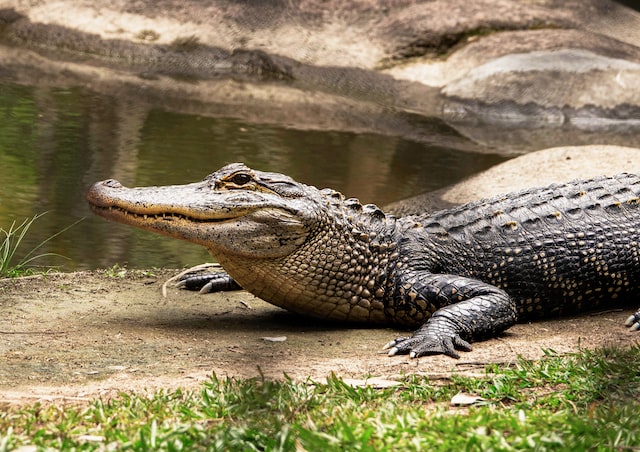Crocodiles, alligators, and gharials – these are the apex predators of aquatic ecosystems, instilling both fear and fascination. However, telling them apart can be a challenging task for many.
In this comprehensive article, we dive into the remarkable world of these reptilian giants, unraveling the key differences that set crocodiles, alligators, and gharials apart.
Whether you’re a wildlife enthusiast, traveler, or simply curious about these majestic creatures, join us on this journey as we explore their distinct characteristics, habitats, behaviors, and much more.
However, when we talk about crocodiles, we’re talking about genuine crocodiles. Characteristics of the jaws and skull are particularly useful in separating the three families of crocodilians. All crocodiles have the same basic skeleton in their skulls and jaws, and they all serve the same purpose.

It’s true that different bones contribute to different structures in varying degrees, though. Lucky for us, there are external features of the skull that can be used to tell apart people from the three Families.
Read Also:
Comparing Alligator vs. Crocodile vs. Caiman vs. Gharial
Crocodiles, in contrast to alligators, caimans, and gharials, have the potential to attain far greater sizes. Further, they exhibit morphological differences, such as in the profile of their muzzles.
Alligators
The wide, “shovel-shaped” muzzles of most allligatorids are a distinguishing feature of this group. Because of the upper jaw’s extreme width, many lower teeth find comfortable homes in the corresponding sockets around the outer border of the upper jaw when the jaws are closed.
The lower jaw’s fourth premolar is disproportionately huge in all crocodilians. When the jaws of an alligator or caiman are closed, the tip of this tooth is tucked into a socket in the upper jaw.
As of now, seven different alligatorid species exist across four different families (Alligator, Caiman, Melanosuchus, Paleosuchus). “alligators” refers to the American Alligator (Alligator mississippiensis).
“True” Crocodiles
As opposed to alligators and caimans, “genuine” crocodiles have narrower upper jaws. Also, the snout is narrowed or notched very severely. Unlike alligators and caimans, “genuine” crocodiles have an enlarged fourth tooth on the lower jaw that sits in that notch, the tip of which is always visible when the jaws are closed.
An important distinction between “real” crocodiles and other reptiles like alligators and caimans is their lack of this trait. True crocodiles (Crocodylus, Osteolaemus, and Mecistops) number in at 14 different species.
Gharials
Extremely long snouts are characteristic of the Gharial (Gavialis gangeticus) and Tomistoma (Tomistoma schlegelii). This lengthening has been accomplished less by whole head elongation and more by cranial (back) skull compression.
As a result, a 3 m long Gharial has a somewhat similar head length to a 3 m long Saltwater Crocodile; the difference being that the Gharial’s head is much more heavily weighted toward the snout.
Alligators vs. Crocodiles vs. Gharial: Size
On average, saltwater crocodiles are three feet longer than alligators, making them the largest and most powerful members of the Crocodylia family. The largest reptiles are crocodiles, which may reach lengths of 20 feet and weights of 2,370 pounds.
Alligators can reach a maximum length of 13 feet and a weight of 790 pounds, with the heaviest specimens ever documented weighing 1,380 pounds. Some species of caiman can be fairly little, topping out at 6.6 feet and 88 pounds.
The Amazon is home to the Black Caiman, which may reach a length of 14 feet and weigh up to 1,300 pounds. In the end, the Gharial can grow to be 20 feet long and weigh a pound or more.
Physical Characteristics
- Crocodile: Crocodiles are massive, with V-shaped snouts. They have visible upper and lower teeth even when their mouths are closed. Their skin is rough and V-shaped scales are prominent. They are often grayish-green or brown.
- Alligator: Alligators are generally darker in color, often appearing black. Their snouts are U-shaped, with only their upper teeth visible when their mouths are closed. The skin on their belly is softer and more uniform in texture.
- Gharial: Gharials have a distinctive long, thin snout, with a bulbous growth at the tip. They are olive-green or brownish and have a pronounced ridge running down their snout. Their body is slender compared to crocodiles and alligators.
Habitat and Range
- Crocodile: Crocodiles are found in various parts of the world, inhabiting both saltwater and freshwater habitats. They can be seen in Africa, Asia, the Americas, and Australia. Species like the Nile crocodile and the American crocodile are well-known examples.
- Alligator: Alligators are primarily found in the southeastern United States and China. The American alligator is the most prominent species, residing in freshwater habitats such as swamps, marshes, and rivers.
- Gharial: Gharials are native to the Indian subcontinent, with a range that includes India, Nepal, and Bangladesh. They prefer slow-moving rivers and are critically endangered, with a limited distribution.
Behavior and Diet
- Crocodile: Crocodiles are known for their aggressive behavior. They are opportunistic predators and have a diverse diet that includes fish, mammals, birds, and even other reptiles. They are ambush predators, relying on stealth to capture their prey.
- Alligator: Alligators are generally more docile compared to crocodiles. They have a diet that consists mainly of fish, turtles, and birds. They are patient hunters and often wait for their prey to come within striking distance.
- Gharial: Gharials primarily feed on fish. Their long, slender snouts are adapted for catching fish, and they rarely pose a threat to humans or large mammals.
Conservation Status and Conclusion
Crocodiles and alligators are more widely distributed and less threatened compared to gharials. Gharials are critically endangered due to habitat loss and hunting.
Read Also:
- How Big Does a Hedgehog Get
- Which Direction Does the Earth Rotate?
- The Butchering Art: Joseph Lister’s Quest to Transform the Grisly World of Victorian Medicine